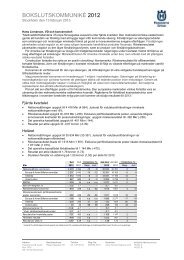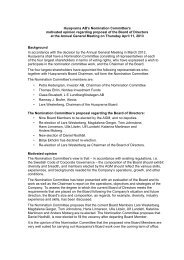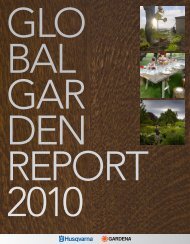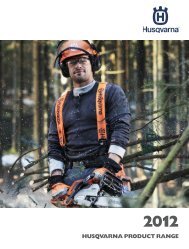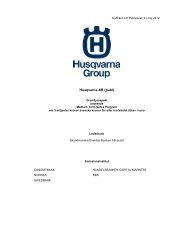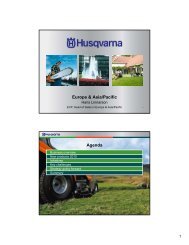Annual Report 2009 - Husqvarna Group
Annual Report 2009 - Husqvarna Group
Annual Report 2009 - Husqvarna Group
Create successful ePaper yourself
Turn your PDF publications into a flip-book with our unique Google optimized e-Paper software.
62 <strong>Husqvarna</strong> <strong>Annual</strong> <strong>Report</strong> <strong>2009</strong> Notes<br />
Amounts in SEKm unless otherwise stated.<br />
Cont. Note 2<br />
Transaction exposure from commercial flows<br />
The Financial Policy stipulates hedging of forecasted sales<br />
and purchases in foreign currencies taken into consideration<br />
the price fixing periods and the competitive environment.<br />
Normally, 75–100% of the invoiced and forecast flows are<br />
hedged up to 6 months, while forecast flows for 6–12 months<br />
are hedged between 50% and 75%. <strong>Group</strong> subsidiaries primarily<br />
cover their risks in commercial currency flows through<br />
<strong>Group</strong> Treasury. <strong>Group</strong> Treasury assumes the currency risks<br />
and covers such risks externally by utilizing currency derivatives,<br />
for which hedge accounting is applied.<br />
The table below shows the forecasted transaction flows<br />
(imports and exports) for the 12-month period of 2010 and<br />
hedges at year-end <strong>2009</strong>.<br />
Commercial flows<br />
Currency<br />
2010<br />
Forecast<br />
flow SEKm<br />
31 Dec <strong>2009</strong><br />
Total hedge<br />
amount<br />
SEKm<br />
<strong>2009</strong><br />
Forecast<br />
flow SEKm<br />
31 Dec 2008<br />
Total hedge<br />
amount SEKm<br />
EUR 2,473 –2,266 2,597 –2,370<br />
CAD 1,017 –633 1,043 –771<br />
RUB 598 –390 542 –362<br />
PLN 385 –275 459 –345<br />
GBP 365 –265 410 –335<br />
Other 1,193 –586 1,652 –628<br />
USD –2,667 2,035 –2,174 1,802<br />
SEK –3,364 2,380 –4,529 3,009<br />
The effect of hedging on operating income amounted to<br />
SEK –109m (–89) during <strong>2009</strong>. At year-end <strong>2009</strong>, the unrealized<br />
exchange rate result on forward contracts amounted to<br />
SEK –57m (–23), all of which will mature in 2010.<br />
Translation exposure on consolidation<br />
of entities outside Sweden<br />
Changes in exchange rates also affect the <strong>Group</strong>’s income on<br />
translation of income statements of foreign subsidiaries into<br />
SEK. <strong>Husqvarna</strong> does not hedge such exposures. The translation<br />
exposure arising from income statements of foreign subsidiaries<br />
is included in the sensitivity analysis below.<br />
Foreign exchange sensitivity from transaction<br />
and translation exposure<br />
<strong>Husqvarna</strong> is particularly exposed to changes in the exchange<br />
rates of SEK and EUR. Furthermore, the <strong>Group</strong> has significant<br />
exposures to USD, CAD, GBP and a number of other currencies.<br />
A 10% increase or decrease in the value of USD, EUR and<br />
CAD against SEK, disregarding any effects from hedges,<br />
would affect the <strong>Group</strong>’s income before financial items and<br />
tax by approximately SEK +/– 133m (276) for one year, using a<br />
static calculation. This assumes the same distribution of earnings<br />
and costs as in <strong>2009</strong> and does not include any dynamic<br />
effects, such as changes in competitiveness or consumer<br />
behavior arising from such changes in exchange rates. It is<br />
also worth noting that, due to the seasonality in <strong>Husqvarna</strong>’s<br />
sales, these flows and results are not distributed evenly<br />
throughout the calendar year.<br />
Exposure from net investments (balance sheet exposure)<br />
The net assets and liabilities in foreign subsidiaries constitute<br />
a net investment in foreign currency, which generates a translation<br />
difference in connection with consolidation. In order to<br />
limit negative effects on <strong>Group</strong> equity resulting from translation<br />
differences, hedging is conducted based on borrowings<br />
and foreign exchange derivative contracts. This means that<br />
the decline in value of a net investment, resulting from a rise<br />
in the exchange rate of SEK, is offset by the exchange gain on<br />
the Parent Company’s borrowings and foreign exchange<br />
derivative contracts, and vice versa. The Financial Policy stipulates<br />
the extent to which the net investments can be hedged<br />
and also sets the benchmark for risk measurement. <strong>Group</strong><br />
Treasury is allowed to deviate from the benchmark under a<br />
given risk mandate. The effect of the hedging is included in<br />
the analysis of the currency compos ition of the <strong>Group</strong>’s net<br />
debt, as shown on page 61.<br />
Hedge accounting of currency risk<br />
<strong>Husqvarna</strong> applies hedge accounting for its commercial flows<br />
and for the hedging of net investments in foreign currency.<br />
The total market value for hedges of commercial flows<br />
amounted to SEK –68m as of December 31 <strong>2009</strong>, of which<br />
SEK –43m is reported in the hedge reserve. Assuming an<br />
unchanged exchange rate, the effects on income after financial<br />
items for 2010 would be SEK –10m for Q1, SEK –25m for<br />
Q2, SEK – 8m for Q3 and SEK 0m for Q4, 2010. During the<br />
year, no ineffectiveness has occurred in relation to the hedging<br />
of net investments while a minor degree of ineffectiveness<br />
has occurred in the hedging of commercial flows in foreign<br />
oper ations. A total amount of SEK 0.2m (0.9) has negatively<br />
affected profit and loss. See Note 16 for the effect on equity<br />
of hedge accounting.<br />
Commodity price risks<br />
Commodity price risk is the risk that the cost of direct and<br />
indirect materials could increase as underlying commodity<br />
prices rise on the global markets. <strong>Husqvarna</strong> is exposed to<br />
fluctuations in commodity prices through agreements with<br />
suppliers, whereby the price is linked to the raw material price<br />
on the world market. This exposure can be divided into direct<br />
commodity exposures, which refer to pure commodity exposures,<br />
and indirect commodity exposures, which are defined<br />
as exposures arising from only a portion of a component.<br />
Commodity price risk is managed through contracts with the<br />
suppliers rather than through the use of derivatives. A ten per<br />
cent rise or fall in the price of steel used in <strong>Husqvarna</strong>’s products<br />
will affect the <strong>Group</strong>’s results before financial items and<br />
tax by approximately –/+SEK 223m (208), everything else<br />
being equal. The same effect on the price of aluminum<br />
would impact the results by –/+SEK 60m (74) and a 10%<br />
change in the price of plastics would give an effect on results<br />
of SEK –/+ 80m (92).



